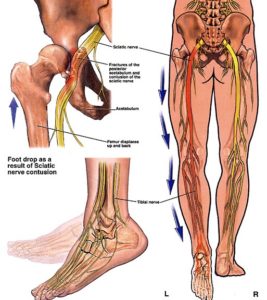Sciatica is pain, tingling, or numbness produced by an irritation of the nerve roots that lead to the sciatica nerve. The sciatic nerve is formed by the nerve roots coming out of the spinal cord into the lower back. It goes down through the buttock, then its branches extend down the back of the leg to the ankle and foot. When something presses on the sciatica nerve, like a herniated disc, it presses on that nerve which causes the pain from the buttock that can radiate all the way down to the foot. The intensity of the pressure on the nerve and where its pressed decides if it goes to the foot or less. Other causes of sciatica nerve damage:
The most common cause -a bulging or ruptured disc in the spine pressing against the nerve roots that lead to the sciatic nerve.
-Sciatica Nerve Damage can be a symptom of other conditions that affect
*Narrowing of the spinal canal due to spinal stenosis. This spinal canal narrowing pinches on the sciatica nerve.
*Bone spurs-they are growths that are small forming along joints caused by arthritis.
*Simply injury (like a car accident or fall) causing nerve root compression=again the same result-pinching the sciatica nerve.
*Pregnancy-not as common as a cause as the others listed.
*Rarely but also tumors could cause the problem also.
What are the symptoms?
Symptoms of sciatica include pain that begins in your back or buttock and moves down your leg and may move into your foot.
*Weakness, tingling, or numbness in the leg may also occur.
*At times a inconsistent stabbing feeling or pricking feeling in the ankle or foot
*Sitting, standing for a long time, and movements that cause the spine to flex (such asexercises using the knee to chest) which may make symptoms worse.
*Walking, lying down, and movements that extend the spine (such as press-ups) may relieve symptoms.
Through the HSS (Hospital of Special Surgery) in NYC, one of the finest hospitals in NY and out of NY states treatment is the following:
Conservative nonsurgical treatment
If you suspect you have sciatica, tell your doctor about the specific duration and character of your symptoms. The doctor will perform a history and physical examination. After appropriate conservative care, X-rays and MRI scans can confirm whether there is a lumbar nerve root compression.
Conservative treatment is aimed at pain reduction and include:
- Applied cold packs or heat
- NSAIDs (non-steroidal anti-inflammatory medications) or other pain medications
- Muscle relaxants
- Alternative therapies such as acupuncture
- Physical therapy
Your doctor or physical therapist may give you instruction about proper bending and lifting to avoid aggravating your condition. In some cases, epidural steroid injections may also help you return to full activity. Most people with sciatica get relief from their symptoms within several months.
Surgical treatment
For those patients who do not respond conservative care and experience persistent, disabling sciatica, surgery may be warranted. Your doctor will determine whether you are a candidate for surgery based on the duration and severity of symptoms. If your condition is causing cauda equina syndrome (which includes symptoms such as bladder dysfunction, incontinence or severe numbness in the buttocks) may be an indication that you should have immediate surgery.
The surgical treatment for sciatica is spinal decompression surgery. The goal is to remove any disc herniation or stenosis (narrowing of canal) that is pressing on the affected lumbar nerve to ease the leg pain and associated symptoms of numbness and weakness. There are several different decompression surgeries, dependent on which nerve roots are affected. They include:
- Laminectomy
- Laminoplasty
- Laminotomy
- Microdiscectomy
In general, more than 90% of sciatica surgery patients have successful outcomes.
